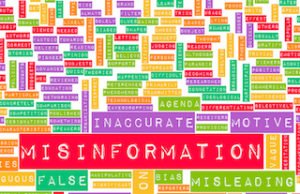“Lying is an elementary means of self defense,” said American author and critic Susan Sontag. Many financial advisors would surely agree with that statement.
Every day, they encounter prospects who lie in order to deflect their sales efforts. And even after they buy, clients may continue to deceive in order to cloak their inability (or unwillingness) to make decisions. Others are ashamed to admit their out-of-control spending or failure to handle important financial tasks. In short, people lie to avoid facing hard truths about themselves — and their advisor’s disapproval.
Dealing with lies every day can get under an advisor’s skin. As one commented on a thread on Insurance Forumsseveral years ago, “You don’t know whether to laugh or to get mad at clients for thinking you’re stupid.”
Rather than laughing or getting mad, advisors should realize that lies simply come with the territory. When you’re working with people on sensitive issues such as retirement, disability, death, and money (especially money!), it’s only natural for people to deceive. If advisors get upset every time this happens, they won’t be advisors much longer.
Still, we believe financial professionals can be a little too accepting of client untruths. When they fail to challenge them, bad things can happen. For example, a smoking prospect who claims to be a non-smoker on a life insurance application can jeopardize her beneficiary’s death benefit if she dies within the two-year contestability period. And what about clients who lie about their shopping or gambling addictions? Can advisors justify ignoring behavior that can devastate a family’s finances?
And there’s the matter of errors-and-omission risk. Working with deceptive clients can lead to intra-family conflict, compliance lapses, and illegal conduct.
The point is this: advisors can safely shrug off most client lies. But some must be challenged to protect the client and the advisor. How? By improving your ability to detect them and by becoming more confident at meeting them head on.
How to detect lies? Our first advice is to ignore a lot of what you read in the popular press. Many self-proclaimed experts suggest that when clients look up and to the left or appear stressed out or nervous are red flags. Wrong! According to Maria Hartwig, Ph.D., an associate professor at the John Jay College of Criminal Justice in New York City, nonverbal behaviors such as gaze aversion, fidgeting, and changing posture have no scientific value in detecting human deception.
In fact, the U.S. Transportation Security Administration invested some $1 billion to evaluate methods of “reading” facial expressions and other nonverbal clues in order to identify terrorists. Government auditors have uncovered few positive results from these efforts. What’s more, a wide-ranging review of the scientific literature revealed people can spot lies only about 47% of the time, which is less than by chance. “The common sense notion that liars betray themselves through body language appears to be little more than a cultural fiction,” Professor Hartwig told the New York Times last year.
Despite scientific debunking, so-called experts continue to argue that signs of emotion and stress are markers of deception. However, many people can easily control their emotions when lying, while others may appear anxious for totally unrelated reasons. A better approach: focus less on emotions and more on the cognitive task of lying itself. In other words, recognize that emotions are easily masked during deception, but cognitive effort is not. So if you can detect a “high cognitive load” and/or reasoning flaws in verbal answers, you’ll be on more solid ground.
For example, let’s say you’re doing fact-finding with a male client (his wife couldn’t get off work). In probing the man’s risk tolerance, you get credible, confident answers. But when you ask about the woman’s appetite for risk, the man stares without blinking and his posture stiffens while he considers his answer. As he describes his wife’s “money personality,” his halting delivery stands in stark contrast to his former speaking style. Based on the cognitive load theory of lie detection, it might be wise push for a separate conversation with the wife to confirm what the husband said.
Experts suggest also watching for behavior such as repeating identical phrases; giving short, superficial answers; pausing between sentences; evading questions; talking in a strangely impersonal tone; and shifting the discussion to third parties and other topics.
In addition to seeking evidence of “cognitive load,” pay close attention to inconsistencies. For example, a client might promise to keep her spouse fully informed about future investment purchases, but refuse to provide his cell phone number for the file. If she was so committed to transparency, why is she so reluctant to provide her phone number?
Also look for inconsistent fact patterns. For example, a client might claim to have no health problems during underwriting for a new life policy. However, an application taken a few years ago revealed a chronic irreversible condition. How can someone have perfect health and a chronic condition at the same time?
• How do you deal with prospects or clients who you suspect of lying to you? Please share your experience on this new thread.
Assuming the aforementioned techniques help you to catch a person in a lie, your first reaction might be to gloss over it. This might be fine with routine lies that are nothing more than buying objections, including:
• “My brother-in-law is my agent.”
• “Just send me some written information and I’ll look it over.”
• “I missed the meeting because I had a doctor’s appointment.”
• “I never received your proposal in the mail.”
Statements such as these might not always be lies. But when a prospect repeatedly dodges your sales probes and closing attempts with flimsy excuses, refocus your efforts on identifying legitimate needs and responding to underlying objections. If the person continues to lie, then consider moving on to the next sale.
However, some client lies are impossible to ignore. Clients who lie in order to prevent a negative event (getting declined for life insurance) or augment a positive event (misstating age to get a larger benefit) should be viewed as trouble magnets. Proceed very carefully in such cases.
So the next time a prospect or client lies to you regarding a serious matter, take a deep breath, then …
• Give the person the benefit of the doubt. Don’t automatically assume the person is lying. Probe to see if there’s a misunderstanding.
• If there is no misunderstanding, call the lie out. Let the client know that it’s in both of your best interests to be completely forthright. Then ask for a clarification of the person’s prior statement.
If the person resists coming clean, make the point that a productive advisor/client relationship demands full transparency and candor. Without it, you won’t be able to do your best work. Plus, if the person isn’t being truthful now, how can you ever fully trust him or her in the future?
Being caught in a lie can upset clients. So gently communicate your empathy and explain you will hold nothing against them. But if they refuse, say you’ll need to reconsider your ability to serve them in the future.
By getting better at detecting and confronting client lies in this fashion, you’ll create a more enjoyable, less stressful work environment, while minimizing errors-and-omissions claims in the future. Why give liars a pass when the vast majority of clients can be counted on to tell the truth?
• How do you deal with prospects or clients who you suspect of lying to you? Please share your experience on this new thread.
For information on ethical sales practices, please visit the National Ethics Association’sEthics Center. For more information on affordable errors and omissions insurance for low-risk financial advisors, visit E&OforLess.com.













